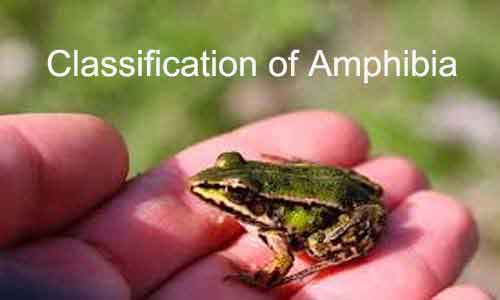The class Amphibia belongs to the subphylum Vertebrata of phylum chordata. All the representatives of Clssa Amphibia are ectothermic, tetrapod vertebrate animals which inhabit a wide variety of habitats including terrestrial, arboreal, fossorial, or freshwater aquatic ecosystems. The name amphibian is derived from Greek word “amphibious” which means “living a double life”. Because some species are permanent land dwellers, while other species show an entirely aquatic mode of life. There are about 8100 known living amphibians, of which nearly 90% are frogs. Amphibians first appeared about 340 MYA (million Years Ago) ago during the Middle Mississippian Epoch of the Paleozoic Era.
The representatives of modern amphibians are frogs, toads, newts, salamanders and caecilians, show several unique characteristic features. They have a wet skin and depend greatly on cutaneous as a secondary respiration but some small terrestrial salamanders and frogs do not have lungs, entirely depend on their skin for their respiration. They also contain green rod in their retina to differentiate colors, two-part teeth and a dual-channeled hearing system.
Paedophryne amauensis is a species of frog from New Guinea which grows up to only 7.7 mm in length while the largest living amphibian is the South China giant salamander (Andrias sligoi) reaching a length of 1.8 m (5 ft 11 in). The science which deals with the study of amphibians is called batrachology.
General Characteristics Features of the Class Amphibia
- Amphibians are ectothermic vertebrate animals.
- They inhabit is a wide variety habitats including terrestrial, arboreal, fossorial, or freshwater aquatic ecosystems.
- The body has two parts: head and neck; in some cases, tail and neck may or may not present.
- They have soft moist pigmented and glandular skin which does not contain any scales but the skin of caecilians contains scales. In this case, skin is smooth and rough and glands keep the skin moist.
- Mouth is large which contains protusible tongue and homodont type teeth.
- There are two pairs of limbs which are used for locomotion.
- The body does not bear paired fins but unpaired fins might be present.
- They perform respiration through skin and lungs. But larval forms respire through the gills. In some case, gills might be present externally in the some adults.
- Digestive system is complete and the heart is three chambered with two auricles and one ventricle; portal system is well-developed.
- The excretory system consists of mesonephric kidney. The excretion is ureotelic and the excretory waste products are ammonia and urea.
- Brain is poorly developed with 10 pairs of cranial nerves.
- The sexes are separate and they usually perform external fertilization. In case for salamanders, the fertilization is internal.
- They are egg layers and usually breed in water bodies. The male does not possess copulatory organs.
- Indirect development occurs. In this case, tiny larval forms with no legs or lungs are seen, known as tadpole larva which is transformed into adult through metamorphosis. In this case most larvae are herbivorous, some omnivorous or carnivorous.
- The lateral line is seen during their larval stage.
- The notochord is present at embryonic stage which does not persist and transforms into vertebra at adult stage.
Classification of Amphibia
Gladwyn Kingsley Nobel (1954), described the classification of Amphibia in his book “The Biology of Amphibia”. He classified the Class Amphibia into two sub-classes, namely Stegocephalia and Lissamphibia, of which Stegocephalia includes all extinct members and other subclass Lissamphibia includes the living members.
Subclass-1: Stegocephalia (extinct)
[Gr. Stegos=cover+ kephale=head]
- They were extinct typically tailed salamandriform amphibians.
- They had well-developed limbs and sometimes of large size.
- Skin covered by ossified scales and bony plates.
- Limbs were pentadactyle (five digits) types.
- Skull had solid bony roofs which possess two pairs of opening for eyes and nostril.
- They were found between Permian to Triassic period of the Paleozoic and Mesozoic eras.
Subclass Stegocephalia is further divided into the following three orders:
- Order-1: Labyrinthodontia
- Order-2: Phylospondyli
- Order-3: Lepospondyli
Order-1: Labyrinthodontia
(Gr. Labyrinthos=maize +odontos=teeth)
- They were the most primitive tetrapods and oldest known tetrapods, called as stem Amphibia.
- They occurred in both water and land.
- They showed characteristic of crocodiles and salamander.
- Their skulls had much bony elements than the modern amphibian.
- Skull and face completely covered by bones.
- Both the jaws had enlarged teeth with greatly folded dentine layer.
- They had equal-sized limbs with well-defined tail
- They lived from Lower Carboniferous to the Triassic periods.
- They inhabited in water.
Order Labyrinthodontia is divided into the following three suborders:
- Suborder-1: Embolomeri
- Suborder-2: Rachitomi
- Suborder-3: Steropondyli
Suborder-1: Embolomeri
- They had fish-like appearance, become visible in the Carboniferous period, and became plentiful during the Pennsylvanian period of Palaeozoic Era and extinct at the end of Triassic period of Mesozoic Era.
- Some had superficially crocodile-like appearance.
- The vertebrae were embolomerous. In this case, an anterior inter-centrum and a posterior pleurocentrum combine to form circular structure.
- They had teeth with dentine that infolded at the base into labyrinthine grooves.
- They had increased-size shoulder girdle.
- The pelvic girdle did not directly attach to the vertebral column. In this case, it held in place via ligament.
- The skull had two or three occipital condyles.
Examples:Eogyrinus attheyi, Loxomma, Palaeogyrinus, etc.
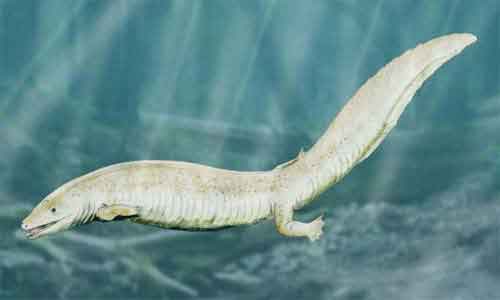
Eogyrinus sp.
Suborder-2: Rhachitomi
- They flourished during the Permian and Triassic Period of geological time scale.
- The skull had two or three occipital condyles.
- They had large depressed skull with large interpterygoid vacuities and otic notch.
- They were about 150 cm long having short powerful legs with five toes.
- The vertebrae were rhachitomous type with a semilunar wedge-like inter-centrum and one or two posterior pleurocentra.
Examples:Eryops, Cacops
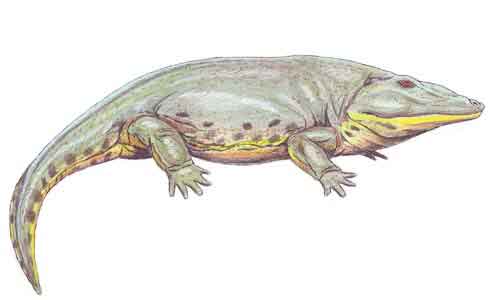
Eryops
Suborder-3: Steropondyli
- They lived at Triassic period of Mesozoic era.
- The skull had two occipital condyles.
- Vertebrae with inter-centrum but pleurocentrum reduced or absent.
Examples:Capitosaurus.
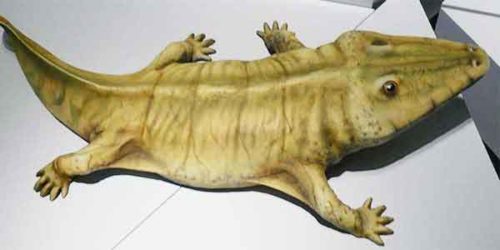
Capitosaurus.
Order-2: Phyllospondyli
[Gr. Phylon=leaf +spondylos=vertebrae]
- They had salamander-like appearance.
- The skull had two occipital condyles.
- Vertebrae were slightly flattened type.
- The nerve cord and notochord remained in the same cavity.
- The skull was broad with heavily roof.
Examples: Branchiosaurus salamandroides
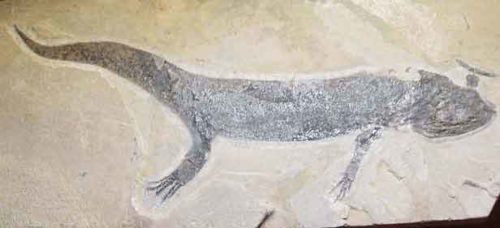
Branchiosaurus salamandroides
Order-3: Lepospondyli
[Gr. Lepos=circular+ spondylos=vertebrae]
- They flourished at late Palaeozoic period of geological time scale.
- The body was small which ranged from a few inches to a few feet in size.
- They had salamander-like or a few superficially snake-like appearance.
- They had lepospondylous type vertebrae. In this case, centra formed directly of bone around notochord, not preceded by cartilage. Centra looked-like spool, neural arch attached to centrum.
- Vertebrae consisted of only one bone.
- Ribs attached with column between vertebrae.
Order Lepospondyli is divided into the following three suborders:
- Suborder-1: Adelospondyli
- Suborder-2: Aistopoda
- Suborder-3: Nectridea
Suborder-1: Adelospondyli
- They lived at Permian period of geological time scale.
- The neural arches loosely attached to centrum with suture.
- A pair groove situated at each vertebra ventral-laterally.
- The skull was incompletely roofed; circumorbital bones disappeared.
- Gill breathing respiration occurred in adult.
Example:Lysorophus.
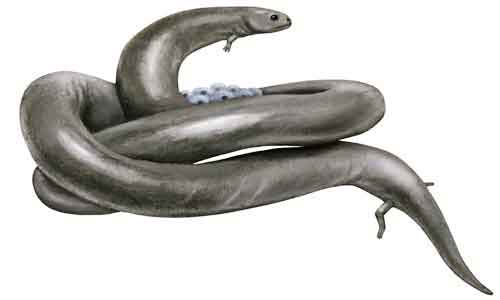
Lysorophus.
Suborder-2: Aistopoda
- The body was elongated, most of them were feetless.
- They had long skull with clear transverse process.
- Ribs were peculiar type.
Example:Ophioderpeton
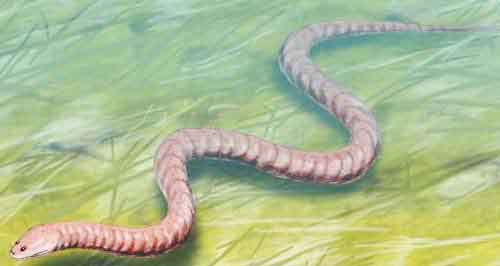
Ophioderpeton
Suborder-3: Nectridea
- Skull was triangular type.
- Broad neural and haemal process were present at the tail region.
- They had small arms and jaws.
- They had long flattened tails which are used for swimming.
- Shoulder girdles were wide and possess a short rear extension.
- Hind limbs were well-developed with five toes on each leg.
- They had slightly reduced forelimbs.
Example:Urocordylus
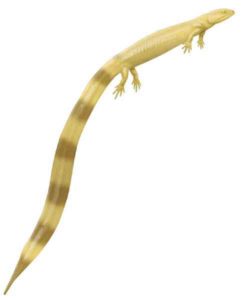
Urocordylus
Subclass-2: Lissamphibia
- All modern living amphibians belong to the subclass Lissamphibia.
- The body possesses two types of skin glands such as mucous and granular.
- One pair of occipital condyles are present.
- Gonad and fat bodies are linked together.
- The inner ear contains double-channeled sensory papillae.
- They have the ability to elevate the eyes using the levator bulbi muscle.
- A special type of visual cell, known as green rods is present.
- Centram (plural: centrum) of the vertebrae are cylindrical type.
- Small and simple pedicellate teeth are present. In this case, crowns are separated from the roots by fibrous tissue.
- Lack of posterior skull bones.
- The skull possesses widely separated and small pterygoid bones.
- Dermal bony plates over the skin are absent.
The subclass Lissamphibia includes the following three orders of living amphibian:
- Order-1: Gymnophiona/Apoda
- Order-2: Caudata
- Order-3: Salientia/Anura
Order-1: Gymnophiona/Apoda
[Gr. Gumnos=naked+ophioneos=snake /Apoda(Gr. A=none+podos=foot]
- The body is elongated worm/snake like with no legs.
- The representatives of this order are blind and inhabit in burrows.
- The tail is short or absent and the cloaca is terminal.
- Protrusible tentacles are present between nostril and eyes.
- Protusible copulatory organ is present in the males.
- Fertilization is either internal or external. In Typhlonectess, fertilization is external.
- Eyes do not bear eye lids.
- Skin bears numerous transverse folds which contains dermal scales.
- Compact skull which is roofed by bones.
Examples:Ichthyophis glutinosus, Typhlonectes compressicauda, Uraeotyphlus oommeni, etc.
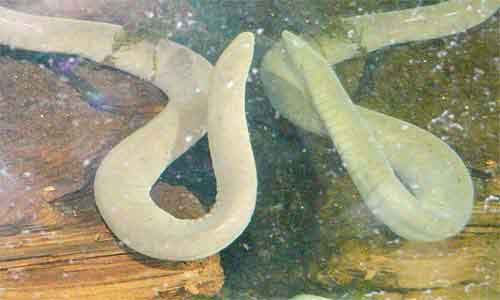
Typhlonectes compressicauda
Family-1: Caecilidae
- They inhabit in burrows of moist soil.
- Some members lay eggs in moist soil while some other give birth to live babies. The eggs hatch into larvae which live in leakage in soil or streams.
- The body is generally slender and can grow up to 1.5 meters in length.
- The body colors vary from dark bluish slate to light gray with visible annuli.
- The skull possesses relatively few bones.
- The body does not have tail and the mouth is recessed beneath the snout.
Examples:Caecilia abitaguae, Caecilia albiventris, Oscaecilia bassleri, Oscaecilia elongate,etc.
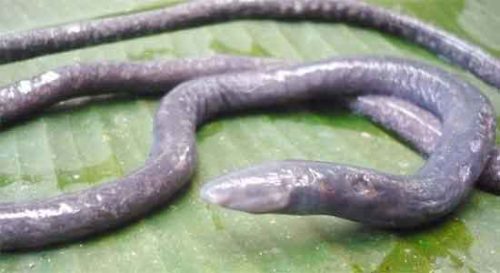
Oscaecilia bassleri
Family-2: Typhlonectidae
- They are commonly called aquatic caecilians.
- They inhabit in water for entire life.
- Eyes are very prominent.
- They are viviparous and give birth to live babies.
- The body length ranges from 140-750 mm.
- They possess tracheal lungs and narial plugs.
- The lower jaw bears two series teeth.
- They lack annular scales as well as secondary annuli.
- Some species are fully aquatic.
- They have compressed body and dorsal fins.
Examples: Chthonerpeton arii, Chthonerpeton braestrupi, Nectocaecilia petersii, Typhlonectes natans, etc.
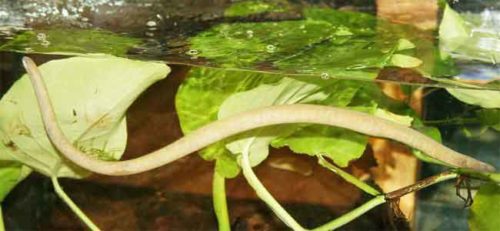
Typhlonectes natans
Family-3: Ichthyophidae
- They are commonly known as fish caecilians or Asiatic tailed caecilians.
- They are distributed in South and Southeast Asia.
- The body bears numerous scales.
- The body has tail and mouths are not recessed under their head.
- For closing the jaw, two sets of muscles are present.
- They are oviparous and they lay eggs in cavities in moist soil.
- The eggs hatch into larvae which inhabit streams or underground leakages. In this case, the females take care for their eggs until hatching.
Examples:Ichthyophis acuminatus, Ichthyophis alfredi, Uraeotyphlus gansi, Uraeotyphlus interruptus, etc.
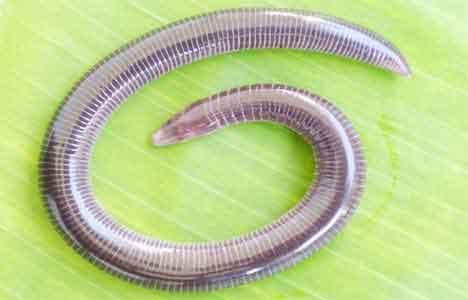
Uraeotyphlus interruptus
Order-2: Caudata / Urodela
[L. cauda=tail) / Urodela (Gr. Oura=tail+delos=visible]
- The body is divided into head, trunk and tail.
- They have lizard-like appearance.
- They are also called Urodela due to the presence of tail.
- Both the fore limbs and hind limbs are equal in size.
- The body does not possess scales and tympanum.
- The gills are presents in some adult forms.
- Some species show neoteny and paedogenesis.
- Males do not have copulatory organ.
- Both jaws bear teeth.
- They are usually oviparous and the larvae are aquatic.
Suborder-1: Cryptobranchoidea
- They are also known as primitive salamanders.
- Premaxillary spines are reduced.
- Gills and eyelids are not present in adult stage.
- Fertilization is external and cloacal glands are complex type.
- Some lead fully aquatic life.
Family-1: Hynobiidae
- They are known as the Asiatic salamanders.
- They are found all over Asia, and in European Russia.
- Teeth on the vomer are V shaped.
- Premaxillary fontanelles are broad.
- Some species perform external fertilization while other reproduces internally.
- They show parental care for their babies.
- The matured female lays up to 70 eggs at a time.
- Some species have very reduced lungs or without lungs.
- Sometimes, the larvae possess reduced external gills.
Examples:Hynobius abei, Hynobius abuensis, Afghanodon mustersi, Batrachuperus karlschmidti, etc.
Family-2: Cryptobranchidae
- They are fully aquatic and commonly known as the giant salamanders.
- They can grow up to 1.9 m (5.9 ft) in length and live up to 50 years.
- They are nocturnal and feed on fish and crustaceans at night.
- Maxillary and premaxillary teeth are arranged parallel.
- Eyes are small with no eyelids.
- Lateral line sensory organ is present.
Examples:Cryptobranchus alleganiensis, Andrias scheuchzeri, Chunerpeton tianyiensis, etc.
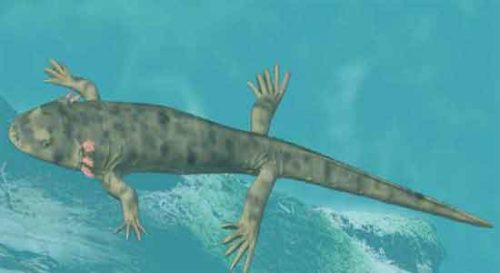
Chunerpeton sp
Suborder-2: Ambyostomoidea
- The body is slender and lizard-like with blunt snouts and short limbs.
- Both larvae and adults possess tail.
- Front limbs bear four toes and five toes on their hind legs.
- They are oviparous and typically lay eggs in water.
- The eggs hatch into aquatic larvae.
- Prevomer is reduced and premaxillary spines are very large.
- Parasphenoid does not contain teeth.
- Vertebrae are Amphicoelous type.
- Cartilaginous cross-bar is present behind the hyoid apparatus between the two ears.
Family-1: Ambystomidae
- They are also known as mole salamanders.
- The body is small to moderate size, with 35 cm in length.
- They usually have well-developed lungs.
- This family contains about 32 species.
- Palatine bones do not contain any teeth while the vomerine teeth are present.
- Most of the species do not contain larval stage but, Ambyostoma tigrinum show larval stage (Axolotl) in their entire life. This process is known as Neoteny.
Examples:Ambystoma tigrinum, Ambystoma amblycephalum, Ambystoma taylori, etc.
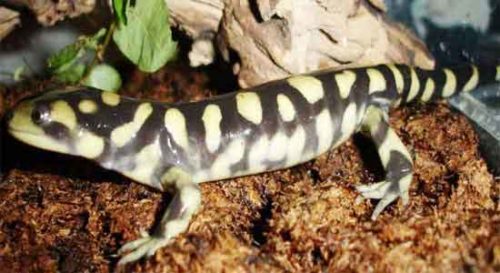
Ambystoma tigrinum
Suborder-3: Salamandroidea
- They are also referred to as advanced salamanders, found worldwide.
- They are aquatic, semi-aquatic and terrestrial.
- The body possesses two pairs of limbs.
- They have small to moderate size body with up to 35 cm in length.
- They have usually well-developed lungs.
- Fertilization is internal through the use of a spermatophore.
- Both juveniles and adults possess lungs.
Family-1: Salamandridae
- This family consists of true salamanders and newts with currently 74 known species.
- They have very granular skin with the number of poison glands.
- They do not contain nasolabial grooves.
- The tail is long and the body has patterns of bright and contrasting colors.
- Limbs are well-developed; the fore limbs possess four toes while five toes on the hind limbs (most cases).
- The size of the body varies from 3 to 12 inches (7 to 30 cm) in length.
- They are viviparous and give birth to live babies.
Examples:Calotriton arnoldi, Cynops chenggongensis, Chioglossa lusitanica, Salamandrina terdigitata, etc.
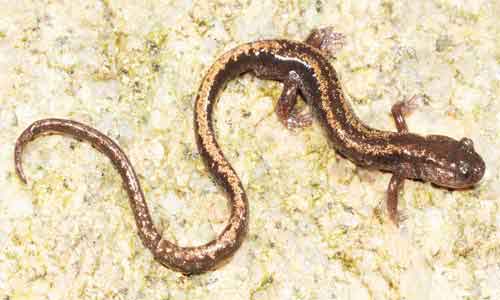
Chioglossa lusitanica
Family-2: Amphiumidae
- They are also known as amphiumas, conger eels, congo snakes.
- The family Amphiumidae contains 3 species under one genus.
- They are large, aquatic eel-like salamanders.
- The body is elongate with generally grey-black in color.
- They can grow up to 116 cm (46 in) in length.
- The legs are very small and merely vestigial with up to about 2 cm (0.79 in) in length.
- Premaxillae are fused.
- Limbs and toes are reduced with 3, 2, or 1 toe per foot.
- They have laterally compressed tail which makes up one third of the total body length.
- They can live up to 27 years and can also grow up to three years without food.
- External gills are present in larval forms which disappear after about four months and the adult forms possess lungs.
- The body also contains one pair of gill slits which never disappears.
- Fertilization is internal and the female lays eggs on land.
- Females take care for their eggs and the eggs hatch into short-lived aquatic larvae.
Examples: Three-toed amphiuma (Amphiuma tridactylum), Two-toed amphiuma (Amphiuma means)One-toed amphiuma (Amphiuma pholeter), etc.
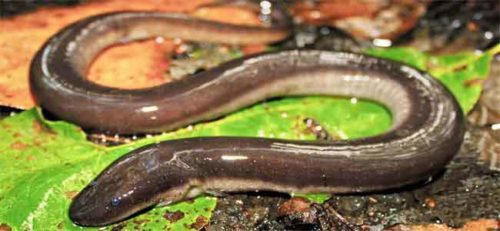
Three-toed amphiuma (Amphiuma tridactylum)
Family-3: Plethodontidae
- The family Plethodontidae consists of about 478 species in 28 genera.
- They are known as lungless salamanders. In this case, they perform respiration through their skin and tissues lining their mouths.
- Naso-labial groove is present which is present between the nostril and upper lip.
- They inhabit a wide variety of habitats including stream, fossorial terrestrial, arboreal, and cave habitats.
- Pterygoid is absent while the otic and occipital elements are fused.
- The body is elongate with up to 60 vertebrae.
- Teeth possess a distinct crown and pedicel.
- Males members have a mental gland.
- Fertilization is internal with direct development occurs.
- They possess four limbs with four toes on the fore limbs and five toes on the hind limbs.
- They lay eggs on land and hatch into young already possessing an adult body form.
Examples: Peter’s climbing salamander (Bolitoglossa), Splay-foot salamanders (Chiropterotriton), Hidden salamanders(Cryptotriton), etc.
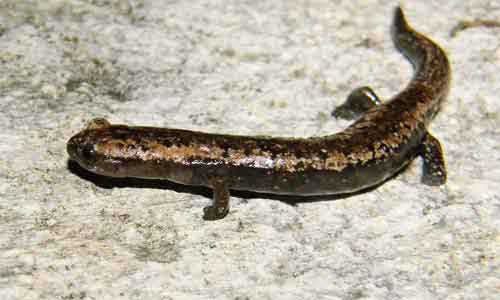
Peter’s climbing salamander (Bolitoglossa)
Suborder-4: Proteida
- They are the aquatic salamanders with persistent long filamentous external gills.
- They have two pairs of reduced limbs with three toes on each forelimb and two on each hind limb.
- The body is elongate with depigmented skin and degenerate eyes.
- The skull is mainly cartilaginous.
- Eyelids and lungs are absent.
- The body also bear a caudal fin.
- They have moderately large-sized body reaching up to 30 cm in length.
- They breed in spring and their fertilization is internal.
- They lay eggs which are attached to the undersides of logs and stones.
- Both male and female guard the eggs until hatching.
- During early summer, eggs hatch into larvae and require 4 to 6 years to reach sexual maturity.
Family-1: Proteidae
- They are exclusively aquatic salamanders, commonly known as Mudpuppies, Waterdogs, Olms, etc.
- The family Proteidae consists of 6 species in 2 genera.
- The body bears large, red, filamentous, external gills.
- Laterally compressed tail fins are present.
- They inhabit wide variety of habitats including lakes, rivers and streams or caves.
- They are distributed in Europe and North America.
Examples: Alabama waterdog (Necturus alabamensis), Gulf Coast waterdog (Necturus beyeri), Neuse River waterdog (Necturus lewisi),etc.
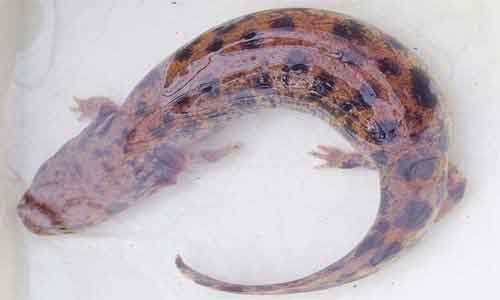
Necturus lewisi
Suborder-5: Sirenoidea
- The body is small to very large with up to 100 cm in length.
- They have only anterior pair of limbs.
- External gills are present throughout the entire life.
- They inhabit lowland waters.
- Angular bone is fused with prearticular bone in lower jaw.
- Fertilization is external.
- Eyelids are absent.
Family-1: Sirenidae
- The body is eel-like with only forelimbs.
- Three pairs of external gills are present.
- The body length ranges from 9.8–37.4 in (25–95 cm).
- They are omnivorous and mainly feed on worms, shrimps, small snails, and filamentous algae.
- During dry season, they can able to burrow into mud and enclose themselves creating a cocoon of mucus for surviving the drought periods. At this time, they perform respiration with their small but functional lungs.
- The heart contains an interventricular septum.
- Males builds a nest for their offspring and engage in parental care.
Examples:Habrosaurus dilatus, H. prodilatus, Noterpeton bolivianum, Siren simpsoni, etc.
Order-3: Salientia / Anura
[L. salere =to jump]
- The order salientia is also known as Anura which consists of the animal-like frogs, toads, and tree toads.
- This order contains about 5,400 known living species.
- The head and trunk are united together.
- In adult stage, they do not have tails.
- Hind limbs are stout and larger in size with highly muscular which are used for jumping, leaping, and swimming.
- Lung is present in adult form but the larval form contains gills for respiration.
- Tympanum is present and the eyelids are well-developed.
- Skeleton lacks ribs and the pectoral girdle is reduced.
- Vertebrae are few in number and last vertebra forms a slender urostyle.
- The body is covered with loosely fitted skin with no scales.
- They usually perform external fertilization and the eggs are laid in water.
Family-1: Ascaphidae
- They are known as tailed frogs. In this case, the tail is the extension of the male cloaca. During the mating period, the tail is used to insert sperm into the female.
- They exhibit internal fertilization.
- The body is small and reaches about 0.98 to 1.97 in (2.5 to 5.0 cm) in length.
- They are mostly aquatic and prefer to live in fast-flowing streams with cobblestone bottoms.
- Adults also forage terrestrially during cool, wet conditions.
- They breed during the months from May to September.
- Females lay their eggs in strings under rocks in fast-moving streams.
- Eggs hatch into larvae which take one to four years to reach maturity.
Examples:Ascaphus montanus, Ascaphus truei , etc.
Family-2: Liopelmitidae
- The leiopelmatids are the relatively most primitive amphibians.
- They are strangely small frogs with only 2.0 inches (5 cm) in length.
- Most of females lay eggs in the moist soil under rocks or vegetation.
- Eggs hatch into tadpole larvae which nest in the back of the male frog.
- They can live up to 30 years or more with favorable conditions.
- Vertebrae are amphicoelous type.
- Tympanum is absent.
- Nine free presacral vertebrae are present.
- Interdorsal and interventral remain cartilaginous.
Examples: Archey’s frog (Leiopelma archeyi ), Hamilton’s frog (Leiopelma hamiltoni), Hochstetter’s frog (Leiopelma hochstetteri), etc.
Family-3: Discoglossidae/ Alytidae
- They are commonly known as painted frogs or midwife toads.
- Eight presacral vertebrae are present.
- Vertebrae are ophisthocolous tyepe.
- Eyelids and tongue are present.
- Most species are endemic to Europe but three species are found in Nortwest Africa.
Examples:Alytes cisternasii , Alytes dickhilleni, Discoglossus galganoi , Latonia nigrivente, etc.
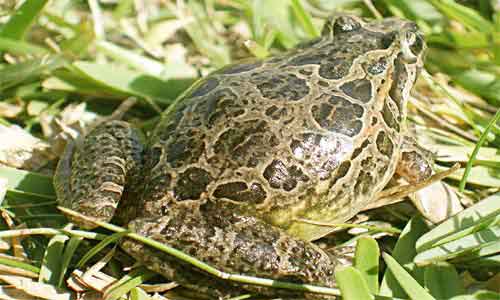
Discoglossus galganoi
Family-4: Pipidae
- They are also known as tongueless frogs.
- The family Pipidae contains 41 species, found in South America and Africa.
- The body is flattened with completely webbed foot.
- The body size ranges from 1.6 to 7.5 inches (4 -19 cm) in length.
- A adult frog possesses lateral line sensory organ.
- They have highly modified ears which are used for producing and receiving sound underwater.
- The tongue or vocal cords are absent. In this case, they use larynx for producing sound.
- Eyelids are absent or poorly developed.
- Sacrum is fused to the urostyle.
Examples:Hymenochirus boettgeri, Pipa arrabali, Xenopus allofraseri
Family-5: Pelobatidae
- They are commonly known as the European spadefoot toads.
- The family Pelobatidae contains six species in one genus.
- These species are native to Europe, western Asia, northwestern Africa, and the Mediterranean.
- They are small to large-sized frogs reaching up to 3.9 inches (10 cm) in length.
- The tongue is pritrusible type.
- They inhabit deserts and other arid regions.
- They have stocky body with vertical pupils.
- They are mostly fossorial frogs which burrow in sandy soils using hardened protrusions on their feet.
- They lay eggs in temporary water bodies.
Examples:Eopelobates anthracinus, Eopelobates bayeri, Pelobates balcanicus, Pelobates varaldii, etc.
Family-6: Myobatrachidae
- They are commonly known as Australian water frogs or Australian ground frogs.
- The size of the body ranges from 1.5 cm (0.59 in) to 12 cm (4.7 inches) in length.
- They lay eggs in the moist sand.
- The eggs directly hatch into miniature frogs.
- They are either terrestrial or aquatic frogs.
- Eight presacral vertebrae are present.
Examples: Northern sandhill frog (Arenophryne rotunda), Bilingual frog (Crinia bilingua), Red-crowned toadlet (Pseudophryne australis), etc.
Family-7: Bufonidae
- The family Bufonidae contains over 570 known species under 52 genera.
- The members of the family Bufonidae are known as true toad.
- They inhabit a wide variety of habitats from arid to rainforest.
- Most species lay eggs in water bodies which hatch into tadpole larvae but for the genus Nectophrynoides, the eggs hatch directly into miniature toads.
- They are toothless with warty in appearance.
- They possess a pair of parotoid glands which are situated on the back of their heads.
- The male possesses Bidder`s organ.
- They have short legs.
Examples:Bufoides meghalayanus, Duttaphrynus melanostictus, Barbarophryne brongersmai, etc.
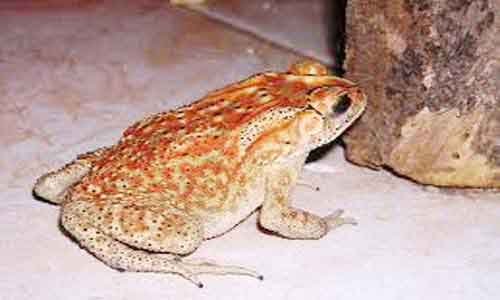
Duttaphrynus melanostictus
Family-8: Brachycephalidae
- They are commonly known as Robber Frogs, Three-Toed Toadlets.
- The family Brachycephalidae contains 74 species in 2 genera.
- They inhabit leaf litter in tropical rainforests but some are arboreal.
- Direct development occurs.
- They are usually diurnal.
- Aquatic tadpoles are most probably absent.
- Bidder’s organ is absent.
Examples:Brachycephalus actaeus, Brachycephalus alipioi , Ischnocnema abdita, Ischnocnema epipeda, etc.
Family-9: Hylidae
- They are commonly called treefrogs, leaf frogs.
- The family Hylidae contains 1003 species in 53 genera.
- Most species are arboreal, some are terrestrial, aquatic or semi-fossorial.
- They lay eggs in ponds, on leaves or in wetlands and marches, or treeholes.
- Eggs hatch into tadpole larvae.
- They are distributed worldwide but many species are found in the North, Central, and South America as well as Eurasia and Australo-Papuan region.
Examples:Hyla arborea, Hyloscirtus albopunctulatus, Argenteohyla siemersi
Family-10: Ranidae
- They are also known as true frogs.
- The family Ranidae contains 410 species in 25 genera.
- They are distributed in North America, Africanorthern South America, Europe, and Asia.
- They have smooth and moist-skin.
- The legs are large and powerful with extensively webbed feet.
- They are aquatic or live close to water.
- The upper jaw possesses teeth.
- The body has smooth slimy skin.
- They lay their eggs in the water and eggs hatch and go through a tadpole stage.
- They have usually a distinct visible tympanum.
Examples:Rana amurensis, Hoplobatrachus tigerinus, Batrachylodes elegans, Amietia amieti, etc.
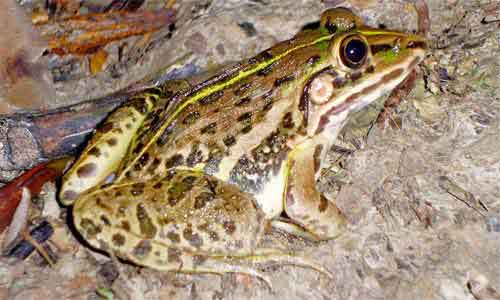
Hoplobatrachus tigerinus
Family-11: Rachophoridae (Polypedatidae)
- They are commonly called shrub frogs, moss frogs or bush frogs.
- The family Rachophoridae contains 200 species in 10 genera.
- Both fore and hind limbs have highly webbed feet.
- Fingers and toes are provided with adhesive disc-like pads.
- The body size ranges from 1.5 to 12 cm (0.59 to 4.72 inches) in length.
- They occur in Africa, India,Sri Lanka, Japan,China, Philippines, Greater Sundas, and Sulawesi.
Examples:Liuixalus calcarius, Nyctixalus margaritifer, Theloderma andersoni, Rhacophorus lateralis, etc.
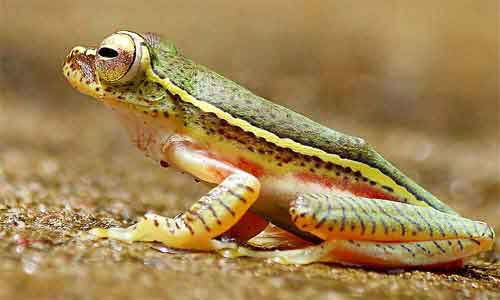
Rhacophorus lateralis
Family-12: Brevicipitudae
- They are commonly Called Rain Frogs, found in eastern and southern Africa.
- The family Brevicipitidae contains 35 species in 5 genera.
- They inhabit forests and desert.
- They are terrestrial and fossorial.
- Adult frogs spend extended periods of time in soil or leaf litter.
- The head is extremely short.
- Development is direct in which fully metamorphosed young hatch directly from eggs.
- They lay small clutches of 13 to 56 fairly large eggs with 4–8 mm diameter.
Examples:Balebreviceps hillmani, Breviceps acutirostris, Callulina dawida , etc.
Difference between Amphibia and Reptilia
Difference between Amphibia and Reptilia are stated in the following table:
|
Amphibia |
Reptilia |
|---|---|
|
Amphibians are cold-blooded animals which live on land or in water. |
Reptiles are also cold-blooded animals. Some live on land and some other live on water. |
|
The body is covered with smooth, moist and highly porous skin with rich in glands. |
The body is covered with dry and hard skin with no glands. |
|
The body does not contain any scales. |
Bony epidernal scales covers the body. |
|
Skull is articulated with the atlas by two occiptal condyles. |
Skull is attached with single median occipital condyle. |
|
They have three chambered heart with two auricles and one ventricle. |
Reptiles also have a three-chambered heart, but their ventricle is further divided through a septum. |
|
Generally, fertilization is external. |
Fertilization is internal. |
|
They lay their eggs in water which are covered with gel. |
Reptiles lay their eggs on land which have a hard protective covering. |
|
Foot is webbed which help them in swimming and jumping. |
Most of them have four limbs which help them in swimming and, running but snakes do not have limbs and they crawl. |
|
They perform respiration through gills or from the lungs. |
Reptiles perform respiration only through lungs. |
|
They are oviparous and they lay eggs covered with gel. |
Some reptiles are oviparous, while some are viviparous. In this case, if they lay eggs which are covered with a hard protective covering. |
|
Some amphibians such as a tadpole larvae have lateral line sensory organ which sense water pressure changes to locate prey. |
Some reptiles have additional sense organ, known as vomeronasal organ or Jacobson’s organ which is located on the roof of the mouth. |
|
Examples: Toads, frogs salamanders, and newts, etc. |
Examples: Crocodiles, Alligators, gavials, lizards, snakes, tortoises, turtles, etc. |
Concluding Remarks
The name “amphibian” is derived from the Greek word amphibios which means “living a dual life”. There are about 8100 known living amphibians, which play an important role in ecosystem to maintain many food chains. They are herbivorous to omnivorous and eat various animals as food items. They also act as the best biological pest controllers. Besides these, they are the good food source of humans. At present, the population of amphibians are decreasing worldwide due to various activities like habitat destruction, climate change, chemical contamination, pollution and diseases, physical environment changes, etc. To protect them, we should take proper conservation measures from their extinction near the future.

